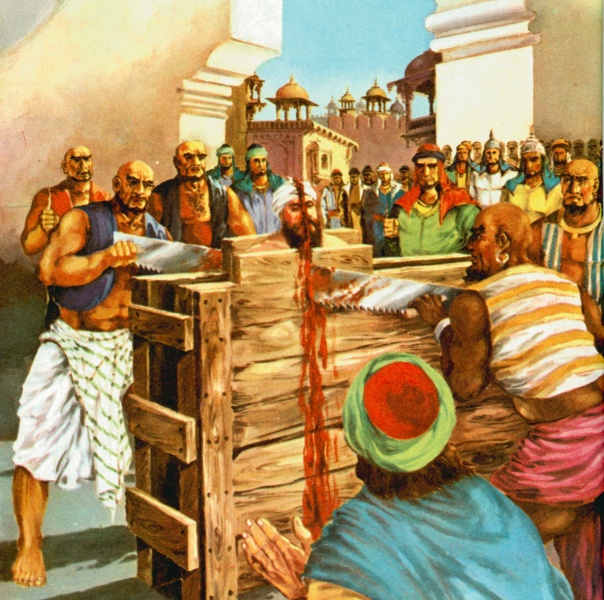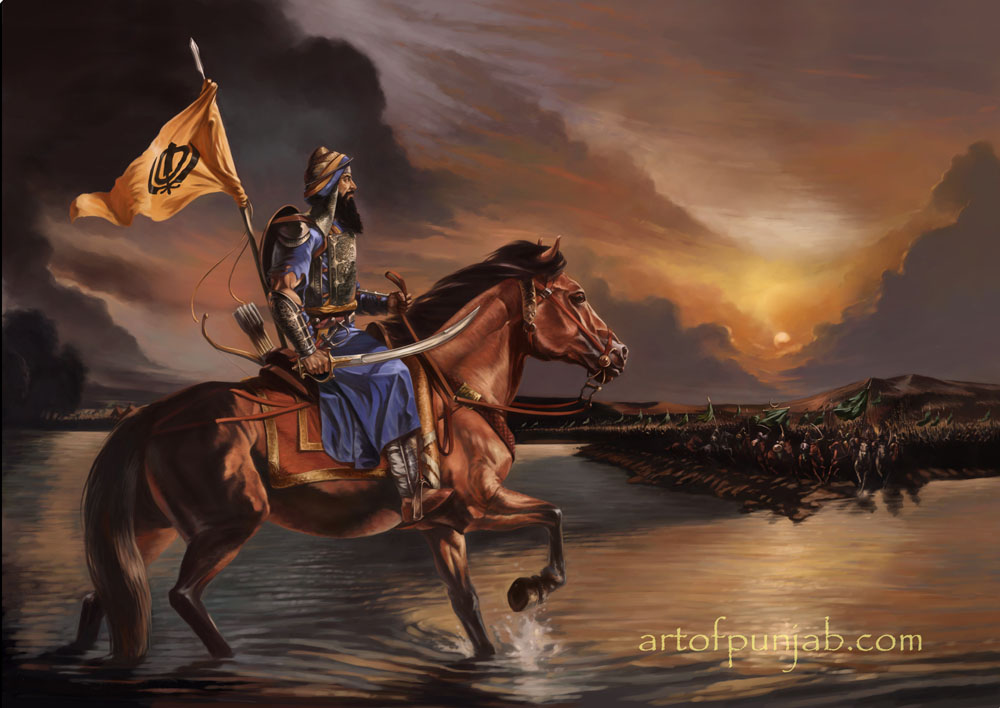 ਸਤਿਗੁਰਬਚਨਕਮਾਵਣੇਸਚਾਏਹੁਵੀਚਾਰੁ॥
ਸਤਿਗੁਰਬਚਨਕਮਾਵਣੇਸਚਾਏਹੁਵੀਚਾਰੁ॥

 ਸਤਿਗੁਰਬਚਨਕਮਾਵਣੇਸਚਾਏਹੁਵੀਚਾਰੁ॥
ਸਤਿਗੁਰਬਚਨਕਮਾਵਣੇਸਚਾਏਹੁਵੀਚਾਰੁ॥

|
The Six Holocausts Of The Sikhs March 08, 2010 08:14AM |
The Six Holocausts Of The Sikhs
Throughout history, Sikhs have had to face much bloodshed. They have often taken up the sword and fought against oppressive regimes and given their lives in battle. There is a strong culture of shaheedee amongst Sikhs, who value death before dishonour, protection of the weak and the preservation of human rights, using all means necessary, including direct action, if all options are closed.
This a short account of six episodes of history in which the Sikhs faced fanatical regimes committed to either annihilating the Sikhs or ensuring that they were as good as dead, without identity, hope or a future.
This IS OUR Story written in Blood of The Khalsa..........
1st Sikh Holocaust 1658
Emperor Aurangzeb became Mughal ruler of India in 1658 and began an era of religious fanaticism. He wished to convert the entire population to Islam and used torture and murder to achieve his goal. The 9th Guru, Siree Guroo Tegh Bahadur Sahib Jee, and his Sikhs Bhai Dyala Jee, Bhai Matee Dass Jee & Bhai Satee Dass Jee were matryed when they refused to give up their Sikhee.
The Sikhs stood bravely against the fanatic policies of Aurangzeb and under the supreme leadership of Guroo Gobind Singh Jee fought and won a number of battles against his armies. Aurangzeb issued an order to his generals to effectively hunt the Sikhs down and kill them wherever they saw them.
In Sirhind, 20,000 Sikhs fled Wazir Khan’s persecution to a perceived safe haven, in the country of the Barakzai Afghans. However, their escorts betrayed them during journey, turning on them and killed every single man, woman and child. This was the first major attempt to exterminate the Sikhs.

2nd Sikh Holocaust 1708-1719
Following the orders of Siree Guru Gobind Singh Jee, Baba Banda Singh Bahadur rallied the Sikhs and established the first Khalsa Raj from 1710-1716. In response to the actions of the Sikhs, the Mughal Emperor, Bahadur Shah, issued a proclamation on 10th December 1710, “to kill the disciples of Nanak wherever they are found”.
The edict was reinforced and repeated bu the next Emperor, Farrukh Siyar, between 1713 and 1719. In this edict, the Sikhs were required to be wiped out of existence altogether. Thousands of innocent Sikhs were killed because of this, many had their heads stuffed with straw and displayed in Lahore. Banda Singh Bahadur was himself tortured to death along with seven hundred Sikhs during a giant spectacle in Delhi in 1716. European witnesses describe how each Sikh proudly refused to give his up faith and were in fact competing with each other to be able to give their head first.
An estimated 25,000 Sikhs butchered in this period.

3rd Sikh Holocaust 1726-1746
On gaining power, Zakriya Khan the governor of Panjab and his vizier Lakhpat Rai relentlessly pursued the Sikhs and ordered that they were to be killed on sight. As an incentive to murder the Sikhs, prices were put on their heads which led to Sikhs being hunted by bounty hunters, scavengers and even neighbours.
The reward for bringing a Sikhs head to the Qazi court was Rs 25 while for a Sikh captured alive its was Rs 100. In addition anyone could plunder Sikh homes if they so wished, anyone giving shelter to the Sikhs was to be executed and anyone giving them Langar was forcibly converted to Islam.
So many Sikhs were killed that pyramids of Sikh heads were arranged in the Lahore horse market, for everyone to see. Sikhs later named this place, Shaheed Ganj, or the “treasure trove of martyrs”.
During a battle, the Sikhs killed the brother of their arch-enemies, Lakhpat Rai. This enraged him to the extent that he vowed to eliminate the Sikhs. With a huge army, he attacked the Sikhs in June 1746 and killed over 7,000 of them. After that, he arrested a further 3,000 people for torture and execution in Lahore. The bodies of these Sikhs were buried under the walls of the local mosque. This was the largest loss of life in a single battle to date and was known amongst Sikhs as Chota Ghalughara (Small Holocaust).
50,000 Sikhs were thus killed in this episode.
4th Sikh Holocaust 1758-1767
The afghan, Ahmed Shah Abdali, invaded India ten times between 1748 and 1768. Characteristically, the Sikhs gave him a hostile reception as they had given to other invaders when they travelled through Punjab. In return, Ahmed Shah pursued the massacre of Sikhs were taken by surprise by Abdalis army. Many of those present in the Sikh camp were elderly, women and children. The Sikh men formed a protective ring around their civilians and fought a moving battle against the aggressors. Over 30,000 Sikhs were killed on 5th February 1762. This event is known in Sikh History as the Vada Galughara (Big Holocaust).
Mir Mannu became the governor of Punjab and restarted the persecution of the Sikh. He became famous in Sikh folklore as being “the scythe of the Sikhs” as he sent his men across the country murdering the Sikhs wherever they were found. He notoriously imprisoned many Sikh women and tried to force them to convert. When they all refused, he had their children tortured in front of them placed the dismembered body parts in garlands around their necks. He butchered infants, mothers the elderly and the infirm, he spared none and has the blood of thousands on his hands.
Around 120,000 Sikhs were butchered during these difficult times.
5th Sikh Holocaust
The Sikhs fought for India’s freedom but were betrayed when their Panjab was divided between India & Pakistan. The partition led to devastating rioting and communal violence with Sikhs caught right in the middle.
Even prior to partition, Sikhs were being attacked in West Panjab to force them to leave. Mass killings of Sikhs, who had gathered in Gurdwaras for safety, began to place. In order to avert the dishonour of being raped, many women committed suicide in large numbers. The unlucky girls who were caught were abducted, raped and paraded naked in the streets; their babies were smashed against walls.
Sikhs were forced to flee and leave behind over 700 Gurdwara and many other institutions such as schools, libraries and museums. Nearly 4 million acres of rich fertile land and holdings were left behind by Sikhs in Pakistan compared to the 2.4 million acres left by fleeing Muslims. One particular poignant episode was when a train from Pakistan arrived at Amritsar station with everyone on board savagely mutilated. This in turn resulted in return attacks on Muslims in East Punjab. The Sikhs lost out during partition and independent India did little to assist Sikhs refugees to rebuild their lives.
The worst tragedy was the immense loss of life. Nearly 2.5% of the Sikh population was butchered in this holocaust with 40% of their population becoming homeless

6th Sikh Holocaust 1984-1995
The response to the Sikhs asking for equal rights, Indira Gandhi launched a campaign to silence the Sikh voice. Government support was given to anti-Sikh sects and the police was used to murder innocent Sikhs prior to 1984. As the Sikhs started becoming aware of their treatment and began to defend themselves, the government launched a blood thirsty attack on the Siree Harmander Sahib complex, designed to inflict maximum causalities and to destroy the spirit of the Sikhs. However, despite the murders of 10,000 Sikhs and the destruction of Siree Akaal Takht Sahib the Sikhs did not lose heart but rather avenged the attack by assassinating Indria Ghandi just 4 months later.
This was followed by further massacres of Sikhs as government organised mobs attacked, burnt, raped and murdered up to 25,000 Sikhs across India in November of 1984. The politicians responsible for organising these murders still walk free today. The following years saw the Indian state commit genocide against the Sikh people. An estimated 200,000 – 250,000 Sikhs were butchered. This was done under a state controlled media with the world turning a blind eye.
Since 1995, direct killing of Sikhs has diminished but conflict is still being supported by the same agencies as before. Anti-Sikh cults, the biased media, clandestine groups and extremist Hindu organisations are still attempting to malign the Sikhs.
It has been 25 years since beginning of the last Sikh genocide and Today, the Sikhs continue in their struggle for justice and liberty, Whilst never forgetting the sacrifices of our ancestors, the Sikhs b learning their own History, must reflect on how to defend themselves as community to ensure that history does not repeat itself. Rest assured, IF SUCH DAYS DO BEFALL THE KHALSA PANTH AGAIN, IT WILL SURVIVE AS ALWAYS & INCREASE IN ITS GLORY & MAGNIFIENCE.

Raaj Karega Khalsa! Panth Kee Jeet!
Taken From In Memory Of Martyrs Pustak
|
Re: The Six Holocausts Of The Sikhs March 08, 2010 08:46AM |
The first 4 holocausts written in the above post resulted in the Chardi Kala of Sikhs. After each of these holocausts, Sikhs bounced back stronger but if you do analysis of the last 2 holocausts namely the 1947 one and the 1984-1992 one, Sikhs did not bounce back stronger. What could be the reason for this? We need to do vichaar on this.
The reason that I can think of at this time is that up until the 4 holocaust, the spiritual life of Sikhs was very strong. A vast majority of Sikhs were strict in keeping Rehit but if we look at the spiritual condition of the Sikhs during the last two holocausts, we notice that a vast majority of Sikhs were not at all strict in Rehit and had a very minimal spiritual life. This is the reason, in my opinion, why Sikhs did not come out strong after these holocausts.
Kulbir Singh
|
Re: The Six Holocausts Of The Sikhs March 08, 2010 10:12AM |
|
Re: The Six Holocausts Of The Sikhs March 08, 2010 10:41AM |
From my understanding and reading books from 1984-1995 period. The gurmukhs of that period were highly abhyassi. They were the backbone of the morcha and thus lead to khalsa fighting the tyrants in full chardheekala. One should not think that the khalsa went down in last two genocides. it's better to have a positive attitude. Saach Paatshah is with his Khalsa always. The Panth has always been a minority.
Principal Satbir Singh has wrote the following which describes a khalsas character
In worldly speak. Sikhs have been down before. The ਛੋਟਾ ਘਲੂਘਾਰਾ of 1746 A.D. decimated the Khalsa army. Thousands obtained martyrdom. The ਵਡਾ ਘਲੂਘਾਰਾ of 1762 A.D. wiped out scores of families in just a couple of days; almost every Sikh was injured. However, within three 3 months the Khalsa Army uprooted Abdalis Army and sent them packing. Never in this period were the Sikhs spirits down. There were several reasons for their ever hopeful, ever forward looking and confident outlook.
Virtuous Character & Self-Denial
The primary teaching of self denial (renunciation of self interests in favour of the interests of others) is imbibed every day by the sikh in doing their Nitnem:
jau qau pRym Kylx kw cwau, isru Dir qlI glI myrI Awau ]
If you desire to play this game of love with Me, then step onto My Path with your head in hand.
(Siree Guroo Granth Sahib Jee Ang 1412)
The self denial and self sacrifice urge was profoundly entrenched in Sikhs
No Sikh will inform about his own twinge to another, but rather be ready to listen to others.
These were a few of the altruistic qualities of Puratan Gursikhs
From Old Panth Parakash Granth
In Bansavali-Nama it is written that
Due to rentless Simran by those Gursikhs. Mughals were uprooted from Punjab